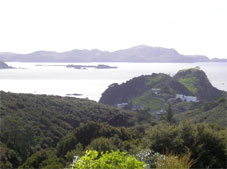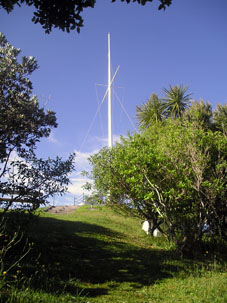
The Flagstaff
reserve is the ultimate viewing spot of the whole Bay of
Islands, high on Te Maiki hill near the geographic centre
of the Bay. This location was the important signalling
point in the early days and after the British colonials
raised their flag on it the Maori chief, Hone Heke, cut
down the pole and sacked the town.
Now you can enjoy the magnificent views, read the history
inscribed at the base of the restored flagpole and pick
out the locations around the bay from the giant mosaic
sundial on the southern high-point across the carpark.
Short tracks lead down through regenerating bush to
Titore Way on the north and to Wellington Street on the
south.
|

History
The sacking
of Kororareka (Russell) in 1844 is detailed in
'A Most Noble
Anchorage' by Marie King. A kauri
flagstaff chosen from Maori chief Hone
Heke's land originally stood at
Waitangi but was moved to Te Maiki in 1834. Later Heke,
previously an ally of the settlers, was insulted and
determined to remove the symbol of British domination
that he feared could rob Maori of their lands and reduce
them to slavery. Missionary William Williams persuaded
him not to chop the flagpole down but on 8 July 1844 one
of his people, Haratua, chopped it down for him.
The British quickly re-erected the flagstaff and sent
troops from Auckland. Hone Heke downed the flagstaff again
in January 1845. Soldiers were again sent from Auckland and
a reward offered for Heke's capture.
The third flagstaff was guarded night and day but Heke
landed in Watering Bay and walked up the slope, alone,
axe in hand, to do the deed once more.
On 15 February 1845 HMS Hazard brought more troops and
a fortified building was erected on Te Maiki adjacent to
the fourth flagstaff sheathed with iron to a height of
three metres. They dug a wide, deep trench around the
blockhouse and set up three cannon in another blockhouse
nearby.
A large supply of gunpowder was landed from the Hazard
and stored in the cellar of a building on the northern
side of the township, which had been built to provide
shelter each night for the township's
women and children. By this time, Maori raiding parties
were rampaging all over the Bay, and refugees were
arriving in Russell to be housed and fed.
First shots were fired on 3 March. Three chiefs Heke,
Kapotai and Kawiti joined forces against the settlers. On
11 March, 600 Maori warriors met up at Te Uruti, and
divided into three. Under a blanket of fog they set out for
Kororareka. Kawiti made his way through Matauwhi Bay to the
corner of the churchyard, and made as much noise as
possible - a distraction. The Kapotai
party attacked from Long Beach (Oneroa). Heke attacked the
flagstaff and its defenders, approaching from the Tapeka
side.
Their plan worked! The settlers were distracted by the
arrival of Kawiti's group, and Heke
and his warriors reached the flagstaff, finding its
sheath of steel a difficult challenge.
Down in the town there was confusion. Casualties,
women, children and personal property were all packed
together - with the gunpowder. Women,
children and wounded were evacuated to the ships and soon
after the gunpowder in the cellar blew up. The town was a
mess; casks of rum were looted and broached. Ppeople died,
some from violence, some in fires.
Next day the Hazard's guns opened up
infuriating the Maori and by nightfall most of the town
was burning.
On 27 April a force of 470 officers and soldiers with
fifty settlers pursued the retreating Maori warriors who
had fled to the Kapotai pa at Waikare. More troops arrived
in Kororareka on 28 April and destroyed
Pomare's pa at Otuihu. Fighting
continued for most of that winter -
battles won and lost. By December the Maori warriors had
retreated to Ruapekapeka, in the southwestern Bay of
Islands. This was an amazing fortified pa, a stronghold of
Kawiti, and here at the turn of the new year, the last
battles were fought.
Tamati Waka Nene, from the Hokianga, was appalled at what
had happened at Kororareka. In October 1846 he invited
Kawiti, Heke and other important chiefs to Kaikohe where
an agreement of sorts was reached.
The current flagstaff was erected in 1857 as a token of
peace and named Whakakotahitanga ('being
of one with the Queen'). Maihi Paraone
Kawiti, a descendant of the chief who fought in the Battle
of Kororareka, led the felling of a kauri spar, its
preparation and carrying up Maiki Hill via Wellington St.
Somehow, via regular restoration, Whakakotahitanga has
survived fire, rot, lightning and intentional damage so
that it is now 150 years old. Earlier this year, halyards
were repaired and new floodlights make it a nighttime
landmark above the town.
The other peak at Te Maiki is a trig station featuring
a large sundial with a beautiful mosaic map of the Bay of
Islands. This was built to celebrate the centenary of the
NZ Institute of Surveyors, 1988.
|